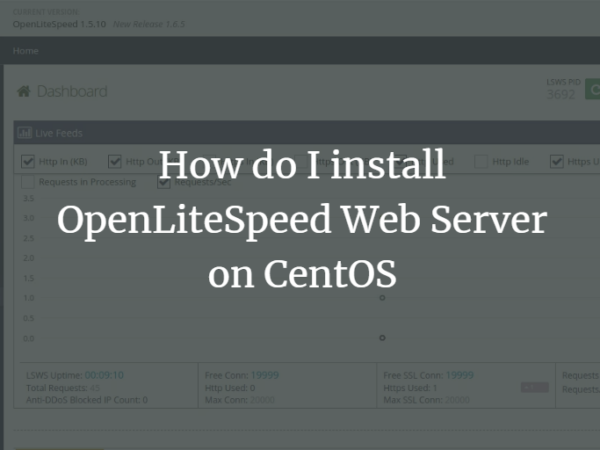Ruby on Rails is a free and open-source web application framework that helps you to create a website with Ruby. Rails is a model–view–controller framework that combines the Ruby programming language with JavaScript, HTML, and CSS to write web applications runs on the webserver and simplifies common repetitive tasks. Rails comes with a set of conventions that helps developers to speed up development without spending a lot of time for file configuration.
In this tutorial, we will show you how to install Ruby on Rails framework on a CentOS 8 server.
Requirements
- A server running CentOS 8.
- A root password is configured on the server.
Install Ruby
The simple and easiest way to install Ruby using the RVM. RVM also known as “Ruby Version Manager” is a command-line tool that can be used to install and manage different Ruby versions from interpreters.
First, install curl and gnupg2 package with the following command:
dnf install curl gnupg2 -yNext, you will need to import the RVM public key on your system:
gpg2 --keyserver hkp://pool.sks-keyservers.net --recv-keys 409B6B1796C275462A1703113804BB82D39DC0E3 7D2BAF1CF37B13E2069D6956105BD0E739499BDBYou should see the following output:
gpg: key 105BD0E739499BDB: 8 signatures not checked due to missing keys gpg: key 105BD0E739499BDB: public key "Piotr Kuczynski <[email protected]>" imported gpg: key 3804BB82D39DC0E3: 108 signatures not checked due to missing keys gpg: key 3804BB82D39DC0E3: "Michal Papis (RVM signing) <[email protected]>" not changed gpg: no ultimately trusted keys found gpg: Total number processed: 2 gpg: imported: 1 gpg: unchanged: 1
Next, download and install the latest stable version of RVM using the following command:
curl -sSL https://get.rvm.io | bash -s stableOnce the RVM is installed, you should get the following output:
Downloading https://github.com/rvm/rvm/archive/1.29.9.tar.gz Downloading https://github.com/rvm/rvm/releases/download/1.29.9/1.29.9.tar.gz.asc gpg: Signature made Wednesday 10 July 2019 04:31:02 AM EDT gpg: using RSA key 7D2BAF1CF37B13E2069D6956105BD0E739499BDB gpg: Good signature from "Piotr Kuczynski <[email protected]>" [unknown] gpg: WARNING: This key is not certified with a trusted signature! gpg: There is no indication that the signature belongs to the owner. Primary key fingerprint: 7D2B AF1C F37B 13E2 069D 6956 105B D0E7 3949 9BDB GPG verified '/usr/local/rvm/archives/rvm-1.29.9.tgz' Creating group 'rvm' Installing RVM to /usr/local/rvm/ Installation of RVM in /usr/local/rvm/ is almost complete:
Next, activate the RVM environment variable with the following command:
source /etc/profile.d/rvm.shNext, install all the Ruby dependencies by running the following command:
rvm requirementsOnce all the dependencies are installed, you should see the following output:
Checking requirements for centos. Installing requirements for centos. Installing required packages: patch, autoconf, automake, bison, gcc-c , libffi-devel, libtool, make, patch, readline-devel, ruby, sqlite-devel, zlib-devel, glibc-headers, glibc-devel, openssl-devel......................................... Requirements installation successful.
You can now list all available Ruby versions with the following command:
rvm list knownYou should see the following output:
# MRI Rubies [ruby-]1.8.6[-p420] [ruby-]1.8.7[-head] # security released on head [ruby-]1.9.1[-p431] [ruby-]1.9.2[-p330] [ruby-]1.9.3[-p551] [ruby-]2.0.0[-p648] [ruby-]2.1[.10] [ruby-]2.2[.10] [ruby-]2.3[.8] [ruby-]2.4[.6] [ruby-]2.5[.5] [ruby-]2.6[.3] [ruby-]2.7[.0-preview1] ruby-head
Now, you can install the Ruby version 2.6.3 using the following command:
rvm install 2.6.3Next, run the following command to set the version 2.6.3 as the default version:
rvm use 2.6.3 --defaultOutput:
Using /usr/local/rvm/gems/ruby-2.6.3
You can also verify the installed version of Ruby using the following command:
ruby --versionOutput:
ruby 2.6.3p62 (2019-04-16 revision 67580) [x86_64-linux]
Install Rails
You can install the latest version of Rails using the gem command as shown below:
gem install railsAfter installing Rails, you can check the Rails version with the following command:
rails -vYou should see the following output:
Rails 6.0.2.1
Conclusion
In the above tutorial, you learned how to install Ruby on Rails on a CentOS 8 server. You can now easily install, manage and work with different Ruby versions using RVM. For more information, you can visit the Ruby official documentation at Ruby Doc.

About Hitesh Jethva
Over 8 years of experience as a Linux system administrator. My skills include a depth knowledge of Redhat/Centos, Ubuntu Nginx and Apache, Mysql, Subversion, Linux, Ubuntu, web hosting, web server, Squid proxy, NFS, FTP, DNS, Samba, LDAP, OpenVPN, Haproxy, Amazon web services, WHMCS, OpenStack Cloud, Postfix Mail Server, Security etc.



